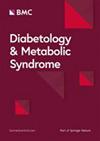脂质代谢物与肌肉疏松症相关特征:孟德尔随机研究
IF 3.4
3区 医学
Q2 ENDOCRINOLOGY & METABOLISM
引用次数: 0
摘要
探讨脂质代谢对肌少症风险的影响。采用双样本孟德尔随机化(MR)分析来确定因果关系。共有 179 个脂质代谢数据点用于暴露,这些数据来自对 7174 名参与者进行的血浆脂质代谢物研究。肌肉疏松症的相关特征包括总肌肉质量和总肌肉力量,以及不同性别组的肌肉力量和肌肉质量。研究结果的数据来自英国生物库,样本量从135 468到450 243不等。反方差加权法(IVW)是评估脂质代谢物与肌肉疏松症之间因果关系的主要方法,它使用假发现率(FDR)进行多重比较,并进行异质性、多因性和反向因果关系检验。研究发现,27种脂质代谢物(主要是磷脂酰胆碱、磷脂酰乙醇胺、神经酰胺、三酰甘油、鞘磷脂和甾醇酯)与肌肉疏松症的风险有关。神经酰胺(d40:1)、神经酰胺(d40:2)和甾醇酯是导致肌肉质量和力量下降的风险因素。各种磷脂酰胆碱脂质与肌肉质量和力量之间存在正向因果关系。磷脂酰胆碱(d42:2)是总肌肉力量和女性肌肉力量的保护因素。不同脂质代谢物、三酰甘油与肌肉力量和肌肉质量之间的影响不一致。27 种脂质代谢物与肌肉疏松症特征之间存在因果关系,针对特定的脂质代谢物可能有利于肌肉疏松症的诊断、疾病评估和治疗。本文章由计算机程序翻译,如有差异,请以英文原文为准。
Lipid metabolites and sarcopenia-related traits: a Mendelian randomization study
To explore the influence of lipid metabolism on the risk of sarcopenia. Two-sample Mendelian randomization (MR) analysis was used to determine causality. A total of 179 lipid metabolism data points were used for exposure, and the data were obtained from a plasma lipid metabolite study of 7174 participants. The total muscle mass and total muscle strength, as well as the muscle strength and muscle mass of different sex groups, were selected as the relevant traits of sarcopenia. Data for outcomes were obtained from the UK Biobank, and sample sizes ranged from 135 468 to 450 243. Inverse-variance weighted (IVW), as the main method for evaluating the causal relationship between lipid metabolites and sarcopenia, uses the false discovery rate (FDR) for multiple comparisons and conducts heterogeneity, pleiotropy, and reverse causality tests. Twenty-seven lipid metabolites, mainly phosphatidylcholine, phosphatidylethanolamine, ceramide, triacylglycerol, sphingomyelin, and sterol ester, were found to be associated with the risk of sarcopenia. Ceramide (d40:1), ceramide (d40:2), and sterol ester are risk factors for decreased muscle mass and strength. There is a positive causal relationship between various phosphatidylcholine lipids and muscle mass and strength. Sphingomyelin (d42:2) is a protective factor for total muscle strength and female muscle strength. There are inconsistent effects between different lipid metabolites, triacylglycerol, and muscle strength and muscle mass. There was a causal relationship between 27 lipid metabolites and sarcopenia traits, and targeting specific lipid metabolites may benefit sarcopenia diagnosis, disease assessment, and treatment.
求助全文
通过发布文献求助,成功后即可免费获取论文全文。
去求助
来源期刊

Diabetology & Metabolic Syndrome
ENDOCRINOLOGY & METABOLISM-
CiteScore
6.20
自引率
0.00%
发文量
170
审稿时长
7.5 months
期刊介绍:
Diabetology & Metabolic Syndrome publishes articles on all aspects of the pathophysiology of diabetes and metabolic syndrome.
By publishing original material exploring any area of laboratory, animal or clinical research into diabetes and metabolic syndrome, the journal offers a high-visibility forum for new insights and discussions into the issues of importance to the relevant community.
 求助内容:
求助内容: 应助结果提醒方式:
应助结果提醒方式:


